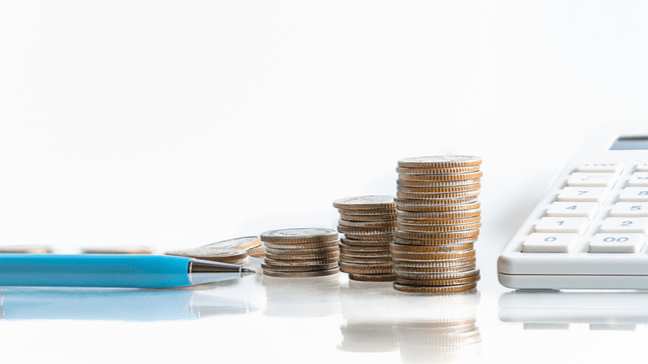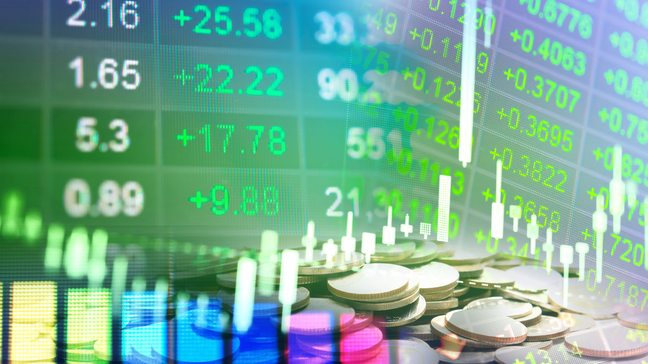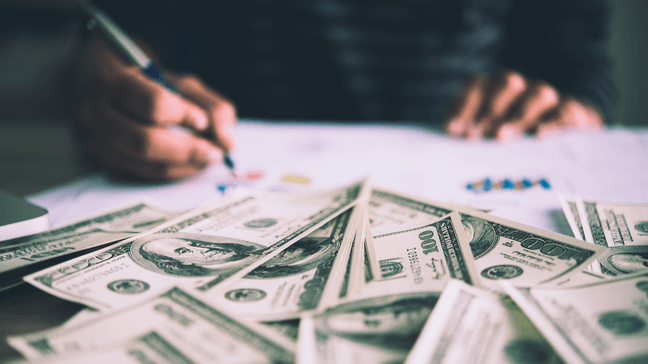Earning income from dividends is a core investment concept all investors need to understand. However, many new investors don’t know what dividends are and exactly how they work within an investment strategy.
So in this article, I’ll help you answer the question “what are dividends” so you can learn how to start making this a stream of income for your existing investment portfolio.
What are dividends?

Let’s start with a definition. Dividends are payments that a company makes to its stockholders. Put another way; some companies will pay you if you own their stock.
Think of dividends as a thank you from the company – it’s a way of giving some of its revenue to the investors who backed it through stock purchases. If you want to earn dividends, make sure to invest in companies that offer dividend stocks.
If you use Robinhood, you’ll find plenty of companies that offer consistent dividends. That includes AT&T, Pfizer, and Exxon Mobil, with each offering dividend yields above 4%. When you purchase stock in these companies, Robinhood will automatically process the dividend and give you the option to reinvest the payment.
So, now you know that dividends are a form of payment. What type of payment, you may ask? That depends. While most dividends come in cash, you can get them in additional stock shares or warrants to purchase stocks.
Stocks
Let’s say you own 50 shares in Banana Boats, Inc., and the company pays 10 cents for each share. You’ll receive $50 every time Banana Boats, Inc. pays dividends. The company may also release a 10% stock dividend, causing your number of shares to go from 50 to 55.
Most people think of dividends as public assets. While you can invest in public companies, such as Altria Group Inc. or National Health Investors Inc. and receive one, dividends aren’t exclusively public options. Private companies also offer them.
Credit unions
One example is a credit union. Credit unions differ from banks because their members own them. When you sign up for a credit union, you become a part-owner. Granted, your share is very small, but you’re a part-owner, nonetheless.
Credit unions reward their members for their loyalty with a regular dividend. The credit union pays people dividends based on the number of stocks they have in the institution. This process varies from its public counterpart because you can only get private shares if you’re a part of the organization.
There is one more stipulation regarding who gets dividends and who doesn’t. Just because you own stock in a company doesn’t mean that you’re eligible for the payout. Companies divide shares into preferred and common stock. As the name suggests, the preferred stockholder often gets dividends while the common stockholders may not.
Who should pay attention to dividends?
Only two types of people need to pay attention to dividends: people invested in dividend-paying stocks and those who plan to invest in them. The first group is straightforward. People that earn dividends have a passive stream of income they want to maintain.
Both current and potential investors can use dividends to evaluate a company’s health. They’re a useful tool for anyone who wants to assess equity and overall return on investment. Using a company’s price-to-earnings ratio provides more insight than does a business’s balance sheet.
Sometimes companies fudge the numbers on their financial statements. Just Google “Enron” for a textbook example of misleading accounting practices. When a business manipulates its earnings to impress investors, it can be challenging to determine what’s real and what’s not.
Dividends aren’t something a company can fake. Yes, you can find companies with excessively high yields, but for the most part, dividends provide a reliable indicator of financial performance. The longer a company’s dividend history, the more confident you can be in your investment.
You should pay extra attention to your dividends when tax season comes. If you have qualified dividends, you’ll only pay a 15% tax on them compared to 25% for regular income. If your income falls below 25%, dividends are tax-free, making it a highly efficient income stream.
Who shouldn’t pay attention to dividends?
Dividends are only a small portion of the investment equation. They shouldn’t make or break your decision to purchase stock. You can think of dividends like a warm cup of cocoa on a frigid winter day. While it’s nice to have and your life is better off with that frothy mug, it is not essential.
Stock Street’s Robbie Schultz offers an excellent explanation of why some people put too much emphasis on dividend yields. Berkshire Hathaway doesn’t pay dividends to investors. Instead, it reinvests 100% of its profit into the organization. If you had invested $10,000 in Berkshire Hathaway in 1964, you would have $134 million today without ever earning a dividend.
If Berkshire Hathaway founder, Warren Buffett hadn’t reinvested profits, his company would not be where it is today. You would also have to deal with some unintended consequences. Instead of your Berkshire Hathaway stock rising every year, it would dip slightly during the dividend payment, and you would have to pay taxes on dividend income.
In the parallel universe where Berkshire Hathaway does pay dividends, the company would be less valuable. You’d have to pay extra taxes, and Warren Buffett wouldn’t have as much money to reinvest into his company. Berkshire Hathaway wouldn’t have grown as quickly, and your $10,000 wouldn’t have become $134 million.
What types of dividends are there?

Most investors receive a traditional dividend. It goes to people who own common stock based on the company’s profitability. You will discover two other types of stock that are worth mentioning:
Cash dividends
Investors can earn a dividend in multiple ways. When it comes to pocketing their payout, many people prefer cash. Investors receive a direct payment whenever a company generates enough income to pay dividends.
Let’s say you own stock in Nike. The sportswear giant announced a quarterly cash dividend in February 2019. If you had outstanding common stock, you would have earned 22 cents per share. Note that you still have to pay taxes on the cash dividend, even if you reinvest it.
Stock dividends
Want to avoid paying taxes immediately on your dividend payments? You might prefer a stock dividend. Some companies have dividend reinvestment plans that allow investors to purchase additional stock in a company slightly below the market price.
Stock dividends benefit the company and its investors. Stockholders gain equity in the organization, and the company doesn’t have to lower its cash balance. Investors only pay taxes on stock dividends when they sell their shares.
Property dividends
Property dividends zig where cash and stock dividends zag. Usually, investors receive money or shares when a company generates a profit. Property dividends provide investors with physical assets, such as real estate or merchandise, or shares in a subsidiary organization.
Companies offer property dividends to avoid diluting their share value. Property dividends can also serve as an alternative if the organization doesn’t have enough money to make payments. Bookkeepers record the dividend at the asset’s market price, though investors can hold onto the property as long as they like.
Scrip dividends
A scrip issue occurs when a company makes new shares and gives them to investors for free. The process is an alternative to legal tender. The company uses its available cash to create new shares and pay shareholders.
Most companies deliver scrip dividends when they don’t have enough money to pay a traditional cash dividend. The scrip issue lets investors choose whether they want cash or shares. While these dividends work similarly to dividend reinvestment plans, they do not incur brokerage or dealing fees because they’re technically not a reinvestment.
Liquidating dividends
Liquidating dividends take place when a company goes through partial or complete liquidation. One perk is that shareholders do not have to pay taxes on them. The liquidating dividends are different than cash dividends because they come directly from the operating profit.
Companies typically offer liquidating dividends when management thinks the enterprise is undervalued. For instance, Miller’s Bakery management believes the business is worth $30 million, but the highest acquisition bid is $20 million. Company leaders may sell some or all of its casts and pay its liabilities instead.
Special dividends
A special dividend, also known as extra dividends, gets its name because it doesn’t have a recurring payment. Companies distribute it to shareholders at irregular intervals, typically with a more substantial payout than their common-stock counterparts. Most special dividends tie into a particular company event, such as an asset sale.
For instance, the Austrian company Red Bull GmbH sold more than six billion cans of energy drinks in 2016, netting it €6.3 billion. The following year, the company paid a special dividend totaling €500 million. That was on top of its €263.4 million in dividends that Red Bull GmbH typically gives to investors each year.
Preferred dividends
A preferred dividend goes to people that own preferred shares. The preferential asset puts its owners first in line when it comes to payouts. If a company can’t pay all investors its dividends, it will pay preferred shareholders first.
Owning preferred dividends does have some tradeoffs. Because most investors purchase preferred shares in large groups, they forfeit their right to vote on certain company matters. For instance, they have no say in the ways business decisions affect shareholders.
Preferred dividends also come with higher yields. This sizeable payout makes them one of the primary reasons that investors purchase preferred stock. Businesses typically make payments each quarter at a fixed rate.
How can people take advantage of dividends?
The first step is to find a company that pays cash or stock dividends. These businesses are usually well-established with a long-term track record of financial success. The year-over-year profitability gives these companies the ability to pay dividends instead of reinvesting it all back into company development.
Some companies that have paid dividends for more than a century include:
- DuPont.
- General Mills.
- Stanley Black & Decker.
- Eli Lilly and Co.
- Consolidated Edison.
- Procter & Gamble Co.
While it’s easy to fixate on dividend yields, the payment isn’t everything. Novice investors may fall into a dividend yield trap. A company can have attractive yields that garner new investors, despite having underlying business issues.
So, how do you avoid the dividend yield trap? You’re better off considering various factors before investing. For example, you should know the payout ratio, which expresses how much of a company’s earnings go towards dividends.
Make sure to also look at:
- Total return.
- Earnings per share.
- Price-to-earnings ratio.
- Cash dividend payout ratio.
- A company’s dividend history.
These markers take into account a broader picture of a company’s financial health. Payout ratios help you measure a dividend’s sustainability, while its dividend history lets you calibrate future returns. Don’t forget to look at the company’s industry and its competitors to watch for outside risk.
How and when you invest your money matters, too. If you want to get more out of your dividend investments, consider Dividend Reinvestment Plan (DRIP).
DRIP allows you to reinvest the dividends you earn from stockholdings automatically. Those dividends go toward a whole or fractional share of stock, depending on the dividend’s size.
A DRIP is a powerful tool for growing your nest egg. All you have to do is sit back and relax. The powers of time and compound interest will do the work for you when it comes to building up your passive income.
What are dividend yields?

Dividend yields tell you how much a company pays in relation to its stock price. People express the financial ratio as a percentage on an annual basis. If you want to calculate a dividend yield, divide the dividend by the stock price.
Dividend yields are essential for transparency. They signal to investors which companies pay back investors the most money. For instance, Company A has a $10 stock paying $.25 dividends each quarter, while Company B has a $1,000 stock and $25 dividends. In both cases, the dividend yield is 10% per year.
I chose a 10% dividend yield on purpose. Seeking Alpha’s Dane Bowler says that any ratios over 10% are risky. You should scrutinize these companies because the dividend yield is likely unsustainable. You should beware of companies that cut their dividends, too.
Like the two ends of a seesaw, yield and stock prices have an inverse relationship. When yields go up, stock prices go down and vice versa. Here are the two ways for dividend yield to rise:
- The company increases its dividend. Company B has a stock price of $1,000 and a dividend of $25. It decides to raise the dividend by 20%. As long as the stock price doesn’t change, you’ll have a higher dividend yield.
- The stock price goes down, but the dividend stays the same. That same $1,000 stock drops to $800. The company keeps its dividend the same. Your dividend yield will increase by the same amount as the first example.
What is a dividend payout ratio?
Everyone has different levels of risk tolerance. Some of us want to bet a small fortune on a dividend-paying stock, while other people would rather invest in bonds and ETFs. One way to check a dividend’s risk level is its payout ratio.
The dividend payout ratio compares the total amount of dividend payments to net income. Some companies pay out all their income to investors, while others retain some of it for operation purposes. If a company pays out more than 100% of its revenue to investors, consider it a red flag.
The ratio can tell you a lot about a company and its maturity. A young company usually wants to continue growing, taking up market share, and expanding its research and development. This approach often goes hand in hand with small or non-existent payouts. A more established company will reward investors for their stock purposes.
Dividend frequency
No rules say that a company has to pay a dividend. It chooses when to pay stockholders and how much. While a company, in theory, could leave you guessing about your dividend payments, most institutions make payments every month, quarter, or year. The exception is the special dividends, which I’ll talk about more in a minute.
If you want to know when your company pays dividends, you need to know three key dates:
- The declaration date. When the board or management teams say it will pay the dividend. The company’s board then votes to approve or deny the dividend.
- The ex-dividend date. The ex-dividend date says you must be on dividend-paying company stock by this day if you want your payment. Most businesses make it one day before checking the list of stockholders. If you buy stock on or after the ex-dividend date, you’ll have to wait until the next payment period. If you sell shares on or after that date, you’ll still get a paycheck.
- The payment date. On this glorious day, you’ll see the dividend payment go into your bank account. All you have to do is figure out how you’re going to spend it.
Why do companies pay dividends?

Some companies may use cash and stock dividends to reward shareholders for investing. Others use them to flex their financial well-being. Dividends send a strong message that a company is stable and has a promising future.
Consistent, well-paying dividends will attract new investors and increase the demand for company stock. They provide a compelling way for investors to earn extra income. If you invest in the right organization, you can see your money double over a seven to eight-year period.
Finding the best dividends
Ready to start earning a regular dividend payment? All you have to do is select a dividend-paying stock. If you need a starting point, check out our review on Public. It’s a free investing platform that provides fractional investing and doesn’t charge commission fees or account minimums.
Some of the most popular high-yield stocks on Public include Johnson & Johnson, Novartis, and SunLife Financial. The app also has a Cash Cows section that shows you which companies have the most cash on hand. It’s one way to gauge your future dividends.
Public is a investing platform with mobile app that has a wide range of offerings and features beginners will appreciate.
With Public, you can invest in stocks, bonds, Treasuries, crypto, ETFs, music royalties and alternative assets—with access to a social feed—all in one place.
- Commission-free trading on stocks and funds
- Fractional shares with low minimums
- High-Yield Cash Account that earns 5.1% APY
- Resources for beginners and community
- Does not support all account types
- No mutual funds
Public has a reinvestment feature that automatically puts your cash dividends back into stocks. The free service is one of the many ways the app makes investing more accessible to people of all budgets. Reinvesting allows you to grow your portfolio while delaying tax payments on dividend income.
Summary
While investing in dividends doesn’t have any hard-and-fast rules, I want to leave you with this thought. Earning a meaningful return requires time and patience. Even an index as powerful as the S&P 500 only returns 2.5% on dividend yields each year. While it may take time to reap the fruits of your labor, it doesn’t mean that the effort isn’t worthwhile.
